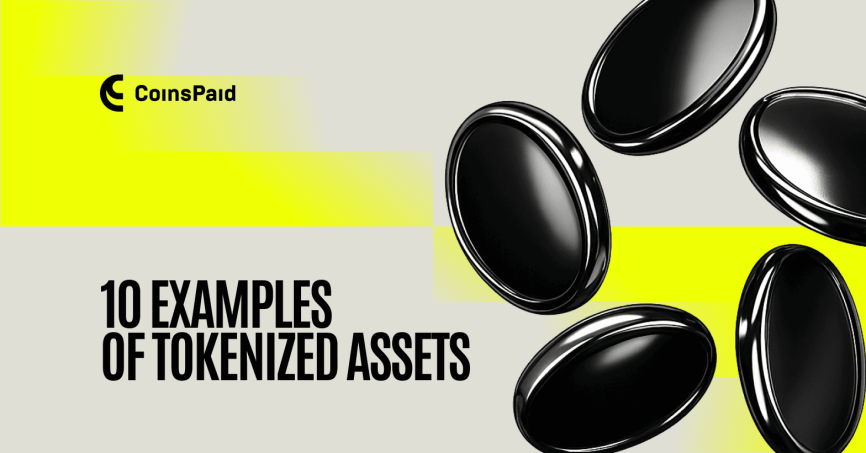10 examples of tokenized assets

Table of contents:
A tokenized asset is a digital unit on a blockchain that represents ownership or rights to a real or digital item. It can stand for real estate, funds, commodities, art, bonds, intellectual property, and more. Businesses use this model to improve liquidity, lower barriers, and manage assets more efficiently. Tokenized assets can be fungible (interchangeable, divisible) and non-fungible (unique, indivisible).
1. Art tokenization
Asset type: Security tokens or utility tokens
Platforms: Masterworks, Maecenas
Companies use tokenization to divide valuable artworks into digital shares. Each token represents a stake in a real piece. It allows global access to art purchases, bypasses full acquisitions, and removes the need for physical handling.
Real-world example of tokenized art: In 2018, Maecenas tokenized a $1.6M Andy Warhol painting, “14 Small Electric Chairs”, on Ethereum. 31.5% of the artwork’s value was sold in tokens to global investors.
2. Commodities tokenization
Asset type: Precious metals, energy, agriculture
Platforms: BlockchainX, OneGold
Digital tokens can represent gold, oil, grain, and other raw goods. Each token matches a fixed quantity of the underlying asset. Holders can gain exposure to the commodity without handling or storing it. It can simplify global trade, enable 24/7 access, and reduce reliance on physical storage.
Real-world example of tokenized commodities: PAXG (Paxos Gold) represents physical gold stored in London’s LBMA accredited vaults. Each token is backed 1:1 by one fine troy ounce of London Good Delivery gold, with reserves audited monthly by independent firms.
3. Real estate tokenization
Asset type: Security tokens / real-world assets
Platforms: Harbor, RealtyShares, RealT
Real estate tokenization turns physical property into digital tokens. It splits a large asset into smaller shares, each tracked on a blockchain like Ethereum. This approach expands investor access and reduces friction in capital flows. Tokenization makes it possible to represent real estate assets digitally, allowing fractional participation without requiring full ownership. Some companies even combine tokenization with crypto payments in real estate to speed up transactions and attract an international investor base.
Tokenized real estate example: A $30M luxury condo development in Manhattan’s East Village was tokenized on Ethereum. It allowed global participation in a formerly closed market.
4. Bonds tokenization
Asset type: Fixed-income securities (security tokens)
Platforms: Obligate (formerly FQX), Securitize, Bitbond
Tokenized bonds represent debt instruments where terms, payments, and compliance are coded into smart contracts. Issuers benefit from faster settlement and lower costs. Investors gain access without needing intermediaries.
Real-world example of tokenized bonds: In 2023, Siemens issued a €60M tokenized bond on Polygon, settling directly between issuer and investor using smart contracts.
5. Equities tokenization
Asset type: Company shares and ETFs
Platforms: FTX (before closure), Binance, Bittrex Global (via CM-Equity)
Tokenized equities give investors digital access to public company shares. Each token mirrors the value of a real stock held in custody by a regulated party. This structure allows fractional ownership and trading outside standard market hours. Businesses can reach new investor groups while reducing administrative overhead.
Real-world example of tokenized equities: FTX offered tokenized Tesla shares (TSLA) through CM-Equity and Digital Asset AG. Investors traded them 24/7, with each token fully backed.
6. Stablecoins (fiat-backed) tokenization
Asset type: Cash equivalents
Platforms: Ethereum, Solana, Avalanche (issued by Circle)
Stablecoins are digital tokens backed by fiat reserves. USDC and EURC, for example, are held against cash and short-term government bonds. These assets support fast, programmable payments and reduce reliance on bank wires or card networks. They are widely used for treasury operations and cross-border crypto payments.
Real-world example of tokenized stablecoins:
USDC enables global companies to move funds across Ethereum and Solana. Each token is redeemable for US dollars through Circle.
7. Carbon credits tokenization
Asset type: Intangible asset
Platforms: Toucan Protocol, KlimaDAO, DeepMarkit
Carbon credits can be converted into blockchain-based tokens. Original certificates are held in custody, and digital versions are issued with traceable metadata. This format supports global trade of carbon offsets, automates retirement tracking, and meets increasing environmental disclosure standards.
Real-world example of tokenized carbon credits: Toucan Protocol created BCT (Base Carbon Tonne) tokens from Verra-issued credits, linking each token to a retired offset.
8. Intellectual property and royalty tokenization
Asset type: Intangible asset
Platforms: IPwe, Royal.io, Opulous
Music rights, patents, and trademarks can be turned into digital tokens. It gives creators and rights-holders a way to raise funds by selling shares of future income. Smart contracts manage distribution and licensing automatically, which reduces administrative costs and improves accuracy.
Real-world example of tokenized royalty: Royal.io lets fans buy royalty tokens for Nas music. It brought over $500,000 in initial sales. Buyers received a share of future streaming revenue.
9. Digital assets tokenization
Asset type: Cryptocurrencies, NFTs, utility tokens
Platforms: Ethereum, Binance Smart Chain, Flow
Digital items like loyalty points, in-game assets, and collectibles can be tokenized. These tokens operate on blockchain, making them tradable and secure.
"Coins are like the residents of the networks, while tokens are like their guests. Knowing the difference is key for anyone getting involved in crypto."
Businesses can use tokens of digital assets like crypto to create interactive ecosystems and open new revenue channels.
Real-world example of tokenized digital assets: CryptoKitties lets users buy, sell, and breed digital cats on Ethereum.
10. Luxury goods and collectibles tokenization
Asset type: Physical luxury goods
Platforms: Mattereum, RealT
Tokenization allows fractional access to rare cars, watches, luxury real estate, and other items. It is used to improve liquidity and build trust through blockchain-based authenticity. Some companies already combine this approach with crypto payments to improve luxury transactions. This model appeals to digitally native audiences because it aligns with how they interact with online platforms.
Real-world example of tokenized luxury goods: Tokenized shares in a rare Ferrari were offered for fractional investment.
Why tokenization matters in B2B
The examples of tokenized assets we’ve highlighted above show that tokenization of digital assets has become a practical tool for business. According to AmericanBanker,
major banks like Citigroup and JPMorgan pilot token-based settlement and payment tools with the purpose of unlocking real-time liquidity. Citi forecasts that tokenization of real-world assets will reach $4–5 trillion by 2030, up to an 80× increase from the level of 2023.
Companies also use tokenized payments to improve cash flow and simplify operations. The main advantage of crypto tokenization for business is flexibility. These features may support more efficient transaction workflows, depending on the business context.
Industries that can find tokenization beneficial:
- Banking and financial services
- Real estate and property
- Supply chains
- Insurance
- Licensing and royalties
- Energy markets
- Retail and marketplace platforms
Why it matters for business:
- Faster cross-border payments
- Lower fraud and chargeback risk
- Better cash flow control
- Simplified reconciliation
- Direct wallet-to-wallet transfers
- Audit-ready transparency
However, this content is not intended for businesses and residents in jurisdictions where crypto-related activities are restricted or prohibited.
CoinsPaid solutions for tokenized assets
CoinsPaid acts as a bridge between businesses that deal with tokenized assets and their customers by providing the payment infrastructure needed to handle crypto transactions. Here’s how it fits into the tokenized asset ecosystem:
- Payment gateway for token purchases. CoinsPaid helps companies accept payments in multiple cryptocurrencies (ETH, BTC, XRP, USDC, and 20+ more cryptocurrencies) from investors or buyers who want to acquire tokenized assets. This broad crypto support increases flexibility and accessibility.
- Crypto-to-fiat conversion. To protect businesses from crypto volatility, CoinsPaid offers automatic conversion of received crypto payments into fiat currency. This simplifies accounting and reduces financial risk.
- Scalability for B2B and marketplaces. It supports complex payment flows for platforms and marketplaces managing tokenized assets and enabling smoother transactions.
In short, CoinsPaid provides the backbone infrastructure that makes buying, selling, and managing payments for tokenized assets practical and trustworthy in a B2B context.
Handling tokenized assets and crypto payments requires careful attention to regulatory frameworks, which differ by country. Businesses should consult legal experts and ensure full compliance with local laws before offering tokenized products or accepting crypto payments. CoinsPaid supports a compliant infrastructure but does not replace legal due diligence.
Note! CoinsPaid does not offer investment advice or security token services. Businesses and individuals should seek regulated financial advice and comply with applicable securities laws before engaging in tokenized asset activities.
Summary
Key Takeaways:
- Tokenization turns real and digital assets — from art and real estate to commodities, bonds, and carbon credits — into blockchain-based digital units.
- By 2030, the global tokenized asset market could reach $4–5 trillion, according to Citigroup, driven by finance, real estate, and supply chain adoption.
- Businesses benefit from greater liquidity, faster settlement, and lower operational costs.
- Tokenization supports fractional ownership and enables 24/7 trading without intermediaries.
- Stablecoins and compliant payment systems like CoinsPaid make tokenized transactions simpler, safer, and globally accessible.
What this means for your business
Tokenization turns real estate, art, and other assets into digital units that work 24/7. Businesses can digitize assets, reach global investors, and move capital faster with transparent, blockchain-based systems. If you run a marketplace or investment platform, crypto payments and stablecoins make funding and payouts more easily accessible. Think of it as a strategic upgrade in your payment flow.
CoinsPaid provides crypto payment infrastructure tailored for companies working with tokenized assets. With 20+ supported cryptocurrencies, fiat conversion, and compliance tools, CoinsPaid helps businesses simplify transactions and reduce exposure to market volatility.
FAQ
Yes, tokenization is legal in Europe, but its legal status depends on the type of token (e.g., utility, payment, or security) and the specific regulatory framework applied. The MiCA regulation, which came into force in 2023 and became fully applicable by the end of 2024, governs crypto-assets like utility and payment tokens. Security tokens, on the other hand, fall under MiFID II and Prospectus Regulation, as they are treated as transferable securities.
Issuers and platforms must comply with these rules to avoid:
- Regulatory sanctions
- Operating bans
- Reputational damage and investor risk
A physical property is split into digital tokens using blockchain. Here’s what it may look like:
- A company acquires or builds a property.
- Tokens are issued to represent ownership or rights.
- Investors buy tokens on a digital platform.
- Smart contracts handle rent, sales, or governance.
- Tokens can be traded, depending on platform rules and local laws.
This model allows fractional investment and greater liquidity.
Yes. CoinsPaid can enable near-instant conversion of stablecoins like USDC into fiat and direct deposit into your business bank account. Businesses don’t need to manage crypto wallets manually. CoinsPaid handles onboarding, wallet setup, and payout automation.
Cryptocurrencies like BTC or ETH are fungible and are typically used for payments. It means each unit is identical and interchangeable. NFTs are non-fungible, every token is unique and represents something specific, like a digital artwork or collectible. NFTs represent ownership of a one-of-a-kind asset.
Utility tokens give access to services or products within a platform. Security tokens represent investment in real-world assets like shares or real estate and are subject to securities laws.
Whether a license is needed to issue tokens depends on the token type and jurisdiction:
- Utility tokens may not require a license if they serve a clear functional purpose and are not classified as securities or payment tokens.
- Security tokens generally require licensing and registration, such as under the SEC in the US or MiFID II in the EU.
- Platforms dealing with trading, custody, or issuance of security tokens may also need to register as broker-dealers, VASPs, or money service businesses.
- In jurisdictions like Singapore, token issuers may be subject to licensing under the Payment Services Act or other financial laws.
It’s always necessary to verify local compliance requirements before participating in crypto activity.
KYC (Know Your Customer) and AML (Anti-Money Laundering) procedures are legally required in most jurisdictions for platforms that issue, sell, or trade tokenized assets with financial or investment characteristics. Platforms must verify user identities, monitor transactions, and use compliance tools. Even for utility tokens, these procedures often apply if the tokens are tradable or used for value transfer.

